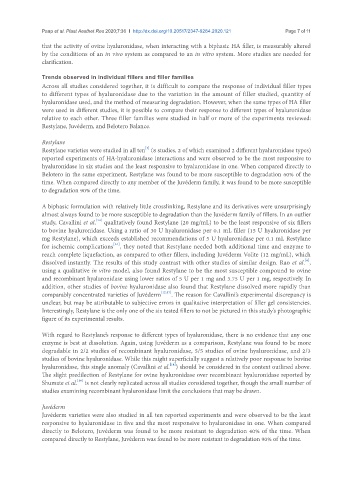Page 397 - Read Online
P. 397
Paap et al. Plast Aesthet Res 2020;7:36 I http://dx.doi.org/10.20517/2347-9264.2020.121 Page 7 of 11
that the activity of ovine hyaluronidase, when interacting with a biphasic HA filler, is measurably altered
by the conditions of an in vivo system as compared to an in vitro system. More studies are needed for
clarification.
Trends observed in individual fillers and filler families
Across all studies considered together, it is difficult to compare the response of individual filler types
to different types of hyaluronidase due to the variation in the amount of filler studied, quantity of
hyaluronidase used, and the method of measuring degradation. However, when the same types of HA filler
were used in different studies, it is possible to compare their response to different types of hyaluronidase
relative to each other. Three filler families were studied in half or more of the experiments reviewed:
Restylane, Juvéderm, and Belotero Balance.
Restylane
[1]
Restylane varieties were studied in all ten (8 studies, 2 of which examined 2 different hyaluronidase types)
reported experiments of HA-hyaluronidase interactions and were observed to be the most responsive to
hyaluronidase in six studies and the least responsive to hyaluronidase in one. When compared directly to
Belotero in the same experiment, Restylane was found to be more susceptible to degradation 60% of the
time. When compared directly to any member of the Juvéderm family, it was found to be more susceptible
to degradation 90% of the time.
A biphasic formulation with relatively little crosslinking, Restylane and its derivatives were unsurprisingly
almost always found to be more susceptible to degradation than the Juvéderm family of fillers. In an outlier
[14]
study, Cavallini et al. qualitatively found Restylane (20 mg/mL) to be the least responsive of six fillers
to bovine hyaluronidase. Using a ratio of 30 U hyaluronidase per 0.1 mL filler (15 U hyaluronidase per
mg Restylane), which exceeds established recommendations of 5 U hyaluronidase per 0.1 mL Restylane
[34]
for ischemic complications , they noted that Restylane needed both additional time and enzyme to
reach complete liquefaction, as compared to other fillers, including Juvéderm Volite (12 mg/mL), which
[6]
dissolved instantly. The results of this study contrast with other studies of similar design. Rao et al. ,
using a qualitative in vitro model, also found Restylane to be the most susceptible compound to ovine
and recombinant hyaluronidase using lower ratios of 5 U per 1 mg and 3.75 U per 1 mg, respectively. In
addition, other studies of bovine hyaluronidase also found that Restylane dissolved more rapidly than
comparably concentrated varieties of Juvéderm [12,17] . The reason for Cavallini’s experimental discrepancy is
unclear, but may be attributable to subjective errors in qualitative interpretation of filler gel consistencies.
Interestingly, Restylane is the only one of the six tested fillers to not be pictured in this study’s photographic
figure of its experimental results.
With regard to Restylane’s response to different types of hyaluronidase, there is no evidence that any one
enzyme is best at dissolution. Again, using Juvéderm as a comparison, Restylane was found to be more
degradable in 2/2 studies of recombinant hyaluronidase, 5/5 studies of ovine hyaluronidase, and 2/3
studies of bovine hyaluronidase. While this might superficially suggest a relatively poor response to bovine
[14]
hyaluronidase, this single anomaly (Cavallini et al. ) should be considered in the context outlined above.
The slight predilection of Restylane for ovine hyaluronidase over recombinant hyaluronidase reported by
[16]
Shumate et al. is not clearly replicated across all studies considered together, though the small number of
studies examining recombinant hyaluronidase limit the conclusions that may be drawn.
Juvéderm
Juvéderm varieties were also studied in all ten reported experiments and were observed to be the least
responsive to hyaluronidase in five and the most responsive to hyaluronidase in one. When compared
directly to Belotero, Juvéderm was found to be more resistant to degradation 40% of the time. When
compared directly to Restylane, Juvéderm was found to be more resistant to degradation 90% of the time.

